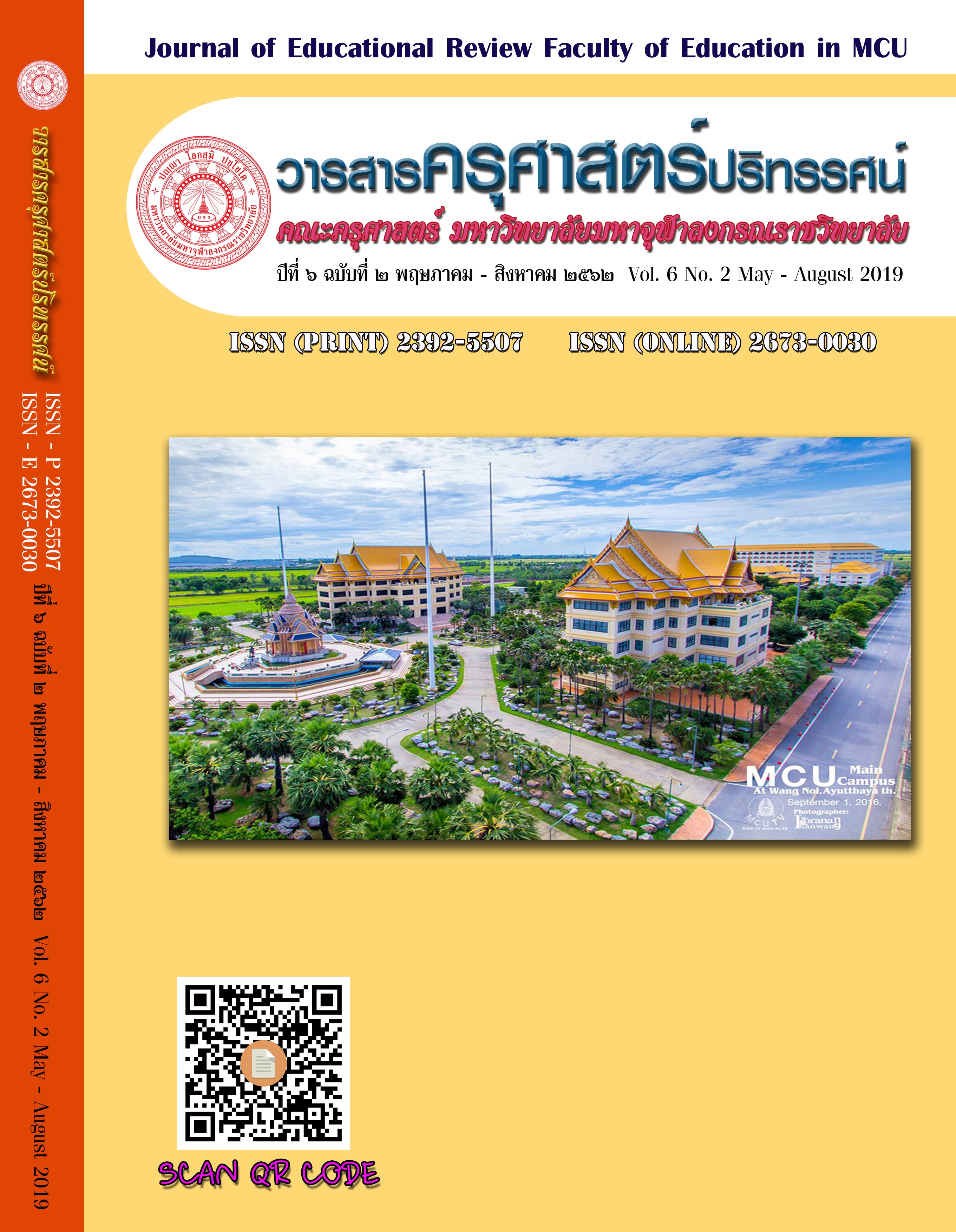Organizational Commitment of Teachers and Teaching Efficiency of Teachers of the Triam Udom Suksa Pattanakarn School Cluster
Main Article Content
Abstract
The objectives of this research were to: 1) study the level of organizational commitment of Teachers of the Triam Udom Suksa Pattanakarn School cluster. 2) study the level of teaching efficiency of teachers and 3) study relationship between organization commitment and teaching efficiency of teachers of the Triam Udom Suksa Pattanakarn School cluster. The sample of 248 employees was selected by stratified random sampling method from population of 704 employees. Statistical method used for data analysis were percentage, means, standard deviation and Pearson’s product moment correlation coefficient. The research results found were follows. The relationship between organizational commitment of teachers and the teaching efficiency of teachers of the Triam Udom Suksa Pattanakarn School cluster revealed that the overall aspects were positively correlated at the high level having a statistically significant level at .01
The findings were as:
1) Organizational commitment of this group in all aspects were at the highest level the item Teachers commitment in terms of willingness to exert high level of effort to serve the organization was ranked at the top, followed by the teachers commitment in terms of strong confidence in the value and goals of organization.
2) Teaching efficiency of overall teachers at the highest level were commitment in Learning ranking at the top. Followed by Lesson’s Clarity and
3) The relationship between organizational commitment of teachers and the teaching efficiency of teachers of the Triam Udom Suksa Pattanakarn School cluster revealed that the overall aspects were positively correlated at the high level having a statistically significant level at .01
Article Details
ทัศนะและความคิดเห็นที่ปรากฏในบทความในวารสารฉบับนี้ถือเป็นความรับผิดชอบของผู้เขียนบทความนั้นเพียงผู้เดียว และไม่ถือเป็นทัศนะและความรับผิดชอบของกองบรรณาธิการ
กองบรรณาธิการขอสงวนสิทธิ์ในการคัดเลือกบทความลงตีพิมพ์และจะแจ้งให้เจ้าของบทความทราบหลังจากผู้ประเมินบทความตรวจอ่านบทความแล้ว
ต้นฉบับที่ได้รับการตีพิมพ์ในวารสารครุศาสตร์ปริทรรศน์ คณะครุศาสตร์ มหาวิทยาลัยมหาจุฬาลงกรณราชวิทยาลัย ถือเป็นกรรมสิทธิ์ของคณะครุศาสตร์ มหาวิทยาลัยมหาจุฬาลงกรณราชวิทยาลัย ห้ามนำข้อความทั้งหมดหรือบางส่วนไปพิมพ์ซ้ำ เว้นเสียแต่ว่าจะได้รับอนุญาตจากมหาวิทยาลัยฯ เป็นลายลักษณ์อักษร
References
ประโยชน์ คุปต์กาญจนากุล. (๒๕๓๑). การวิเคราะห์องค์ประกอบเชิงสาเหตุของประสิทธิภาพการสอนของอาจารย์ในวิทยาลัยครู. วิทยานิพนธ์ปริญญาศึกษาศาสตรดุษฎีบัณฑิต. คณะครุศาสตร์: จุฬาลงกรณ์มหาวิทยาลัย.
ศุภพิชญ์ ศุขโกเมศ. (๒๕๖๐). ปัจจัยที่ส่งผลให้เกิดความผูกพันต่องานและความผูกพันต่อองค์การของบุคลากรที่ดูแลคนพิการ. วิทยานิพนธ์วิทยาศาสตรมหาบัณฑิต การพัฒนาทรัพยากรมนุษย์และองค์การ. บัณฑิตวิทยาลัย: สถาบันบัณฑิตพัฒนบริหารศาสตร์.
ศุภวรรณ หลำผาสุข. (๒๕๕๐). การศึกษาความผูกพันต่อองค์กรของครูโรงเรียนในเครือสารสาสน์ เขตพื้นที่การศึกษา ๑. วิทยานิพนธ์ปริญญาการศึกษามหาบัณฑิต สาขาวิชาการบริหารการศึกษา. บัณฑิตวิทยาลัย : มหาวิทยาลัยศรีนครินทรวิโรฒ.
สัมฤทธิ์ ผิวบัวคำ. (๒๕๔๖). ปัจจัยที่มีผลต่อความผูกพันต่อองค์การของข้าราชการครูในโรงเรียนประถมศึกษา สังกัดสำนักงานประถมศึกษา สุพรรณบุรี. วิทยานิพนธ์ครุศาสตรมหาบัณฑิต สาขาการบริหารการศึกษา. บัณฑิตวิทยาลัย : มหาวิทยาลัยราชภัฏกาญจนบุรี.
โสมย์สิรี มูลทองทิพย์. (๒๕๕๖). ความผูกพันต่อองค์กรของบุคลากรที่ปฏิบัติงานในโรงเรียนมัธยมศึกษา อำเภอท่ามะกา. วิทยานิพนธ์ศิลปศาสตรมหาบัณฑิต สาขาวิชาการจัดการภาครัฐและภาคเอกชน. บัณฑิตวิทยาลัย : มหาวิทยาลัยศิลปากร.
Krejcie R. and D. W. Morgan. (1970). Determing sample size for research activities. Education and Psychological Measurement. 30(3): 607 – 608
Sheldon M. (1971). An empirical analysis of organizational identification. Academy of Management Journal, 14, 149 – 226.
Steers, R.M. (1977). Organizational Effectiveness Behavioral View. California: Goodyear Publishing Company, Inc.


